Gum Slough Kayak (& Canoe) Tour
(X-stream spring adventure) *
Group size: 1 – 24
Trip length: 6 – 7 hours
Skill level: Beginner (physical ability, endurance and determination are needed)
Cost
Most guided tours are $50 per person. (includes boat, paddle, vest, shuttling and your guide)
Using your Own Boat – $40. (many paddlers with their own boats like to join us to learn more about the history, archaeology and natural history of these rivers).
Dates
Join a scheduled tour (see tour calendar ), or suggest one. Find a free date on the calendar and suggest the trip of your choice. If there are no conflicts, we’ll post it!
OR
Schedule a private tour. Use contact form, email us at [email protected] or call (386-454-0611)
Location
Check the River Locator Map or Click the link below for a local map and then use zoom and panning arrows to explore the area. (Note: the marker is NOT our meeting place, but a nearby landmark.
Local Map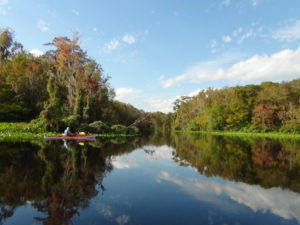 Description
Description
Gum Slough is a network of clear, shallow streams which thread their way through a softly-shaded, semitropical hardwood river forest. Red maple, hickory and ash dominate these river forests, making this a great destination in autumn. Above the slough, the canopy opens and gives way to a beautiful, linear marshland. This is the actual “slough, and it’s here that we find Seven Sisters springs.
Gum Slough can only be accessed from it’s lower end, where it flows into the Withlacoochee River (south). From the public boat ramp at Turner’s Fish Camp, a short, 20 minute paddle on scenic stretch of the Withlacoochee brings us to the unremarkable mouth of the slough. Heading upstream (up-slough?), the many similar looking side-streams that enter and flow out from the main channel, highlight the fact that this is one of those twisted, braided waterways that devours unwary paddlers. Like River Styx, this swamp holds many tales of lost paddlers who’ve spent an unplanned night in the woods, so you’ll want to stay in sight of the group on this leg of the trip. Gum, red maple, hickory, cypress, ash and other wetland species created a closed canopy over the run. This keeps under story vegetation to a minimum, allowing for good visibility through the swamp – especially in winter.
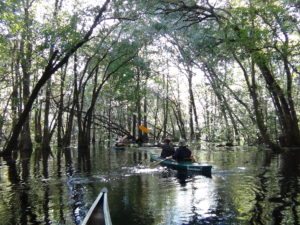 After a couple of hours of winding our way upstream, the canopy slowly becomes more open and the waters edge becomes increasingly decorated with a lush assortment of emergent marsh vegetation. Another half mile and we’ve entered a wide, linear marsh. During much of the year, this has the feel of a lost paradise – hidden from the outside world and alive with color. Shades of purple are found in the blooms of both the native pickerelweed (Pontederia cordata)and it’s unwelcome cousin water hyacinth, an an exotic species brought to Florida in the late 1800’s. Cardinal flower (Lobelia cardinalis) adds its unbelievable version of crimson to the scene, and whites are provided by towering clusters of duck potato blooms and low, shade loving spider lilies (Hymenocalis sp.).
After a couple of hours of winding our way upstream, the canopy slowly becomes more open and the waters edge becomes increasingly decorated with a lush assortment of emergent marsh vegetation. Another half mile and we’ve entered a wide, linear marsh. During much of the year, this has the feel of a lost paradise – hidden from the outside world and alive with color. Shades of purple are found in the blooms of both the native pickerelweed (Pontederia cordata)and it’s unwelcome cousin water hyacinth, an an exotic species brought to Florida in the late 1800’s. Cardinal flower (Lobelia cardinalis) adds its unbelievable version of crimson to the scene, and whites are provided by towering clusters of duck potato blooms and low, shade loving spider lilies (Hymenocalis sp.).
In fall, the show continues as climbing aster bushes take center stage with a burst of small, lavender flowers and bur-marigolds poke their sunny, yellow blooms above the green masses. Taking advantage of every sunny perch offered by their sturdier fellow plants, we find the all-entangling climbing hemp vine (Mikania scandens) with it’s small white flowers and tiny cotton-ball seed heads. More color is added by the deceptively pretty orange 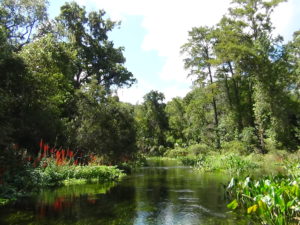 sinews of dodder, the marshes most insidious resident. This parasitic vine threads its delicate, orange coils around the stems and leaves of it’s host, slowly leaching out life-giving water and nutrients. Adding to the attractiveness of the scene are a variety of textures – ragged brown cattail heads shedding their fluffy seeds; Spanish moss waving from the high rigging of cypress, tupelo and ash trees; broad, fan-shaped leaves of cabbage palms. And, below your boat, in the clear spring water you’ll find meadows of waving eel grass, burgundy clusters of red ludwigia, dark green pony-tails of coon tail (Ceratophyllum demersum) – all adorned with crowds of tiny river snails.
sinews of dodder, the marshes most insidious resident. This parasitic vine threads its delicate, orange coils around the stems and leaves of it’s host, slowly leaching out life-giving water and nutrients. Adding to the attractiveness of the scene are a variety of textures – ragged brown cattail heads shedding their fluffy seeds; Spanish moss waving from the high rigging of cypress, tupelo and ash trees; broad, fan-shaped leaves of cabbage palms. And, below your boat, in the clear spring water you’ll find meadows of waving eel grass, burgundy clusters of red ludwigia, dark green pony-tails of coon tail (Ceratophyllum demersum) – all adorned with crowds of tiny river snails.
Wildlife loves this area too. As one might expect, egrets and herons are found here in good numbers. We also see wood storks, yellow crowned night herons and lots of white ibis. Otters are frequently seen too. Literature provided by the SWFWMD (Southwest Florida Water Management District) who owns much of
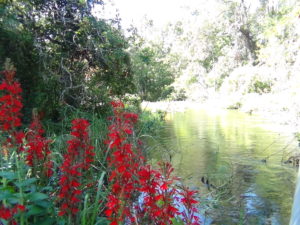 the land we pass through (Carlton Tract and Half Moon Wildlife Management Area), list bobcats, coyotes and fox squirrels as some of the other animals that live here. One of the more unique species we see on this trip is snapping turtles. Whether we’ve just been lucky, or if there really is a greater population up here, I don’t know. But we’ve seen them on about two thirds of our trips up here.
the land we pass through (Carlton Tract and Half Moon Wildlife Management Area), list bobcats, coyotes and fox squirrels as some of the other animals that live here. One of the more unique species we see on this trip is snapping turtles. Whether we’ve just been lucky, or if there really is a greater population up here, I don’t know. But we’ve seen them on about two thirds of our trips up here.
This marsh is also where we find the Seven Sisters springs. And, just as the slough itself gets more impressive as we work upstream, so too do the springs. In fact, the first ones are easily missed, with relatively dark basins and low flow rates. In the last half mile, you start to see limestone outcrops and small boulders scattered on the river bottom. (on this light background, you can really get a sense of the density of tiny river snails that live here). Then, a bend in the river brings you to the beautiful fountainhead. Here, the thrill reaching the end is offset by the presence of a couple of houses. Even so, the beauty of the deep, blue spring is not lost. Drifting over this and a couple of other nearby, equally beautiful boils, its easy to imagine why this was such a popular retreat for early Indians.
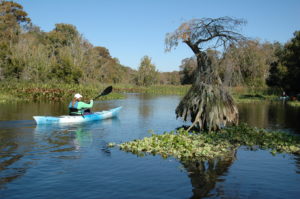 If it weren’t for the lone, stilted house at the beginning of the marshes and the others at the head spring, the magic spell that is cast by this lush, hidden realm would be complete. Even so, Gum Slough still ranks as one of the finest spots in north Florida in my book.
If it weren’t for the lone, stilted house at the beginning of the marshes and the others at the head spring, the magic spell that is cast by this lush, hidden realm would be complete. Even so, Gum Slough still ranks as one of the finest spots in north Florida in my book.
During times of low water, the first three miles of this trip can feel like a little slice of hell – regardless of how much you enjoy the swamp experience. At those times, we list this as one of our x-stream adventures . You’ll be out of your boat frequently as we slowly work our way up-slough, dragging our boats over deadfall and slogging crotch-deep in mud and soft sand where water is too shallow for paddling. But, as with all of our x-stream trips, the work has its rewards.
Highlights
For me, the highlight of this trip is the isolation of the marshes and the springs. The lower springs aren’t very big (in fact some are hard to even locate in the marsh), but they are their wild setting is wonderful. The head springs are larger and clear blue, but the houses detract from the experience. When conditions are bad (i.e. low water and lots of deadfall) some disturbed folks actually enjoy the total workout that this trip becomes, requiring both physical ability and determination. You can spend a day in the gym or you can spend a day trudging your way, crotch deep in through the mud, and emerging at the end with bugs in your hair and crud in your teeth. Is there even a choice?? ; -)
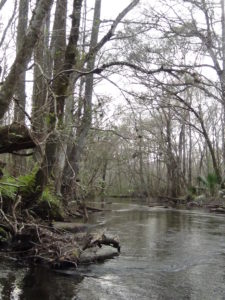 Wildlife
Wildlife
The river swamp along the Withlacoochee River, through which Gum Slough flows, is home to many bird species, especially in the winter when migrants swell the numbers dramatically. Herons, egrets and ibis are common. We also see bald eagles, limpkins, yellow-crowned night herons and swallow-tailed kites (in summer). River otters are also common here. There is also an unusually large population of snapping turtles in the bay area surrounding the springs.
These large turtles reach nearly 20 inches in length and can weigh over 40 pounds. They are very aquatic and we usually see them floating in the water rather than basking on logs like other turtles. They have long been killed by humans who found them tasty, but they don’t go easily. Though they look slow, their “snap” consists of a very quick thrust of their long neck and a powerful bite that is hard to escape. They’re known to eat just about anything that comes their way – plant, animal or carrion, including the occasional human finger! Their much larger relative, the alligator snapper, can weigh 200 pounds. Their range extends from the Suwannee river basin westward.
 History
History
Hernando DeSoto faced some of the greatest hardship of his 1539 expedition in these swamps. Some archaeologists believe their Indian guides deliberately led the Spaniards through the extremely inhospitable Tsala Apopka wetlands, through which you pass as you drive out Turner Camp Road from Inverness to the launch site. In fact, it’s believed the path they followed closely paralleled Turner Camp Road. The Spaniards destination was the nearby Timucua village of Ocale, where they hoped large stores of corn would sustain them through the winter. Ocale, however, wasn’t nearly as rich a village as other tribes had proclaimed, so DeSoto soon moved on to make winter quarters at a village located near today’s downtown Tallahassee. One clue to DeSoto’s having passed close to this area, was the discovery of some Spanish artifacts in a nearby Indian mound.
Most of the Indian place names which dot today’s map of Florida, have Seminole origins. Very few date back to the earlier, Timucua Indians. The city of Ocala, named for the village of Ocale, is one of these rarities.
Difficulty
When water levels are good – this is a long trip, and usually takes a total of 6 – 7 hours. Paddling against the current for three hours can be very exhausting for some paddlers. The return trip isn’t much faster – about 2.5 hours – because the channel is so winding that you can’t take good advantage of the downstream current.
I once mentioned to my young niece, Allie, that we were going to a “gum” swamp and her face lit up as
though we were headed for the circus. It took me a moment to realize she was visualizing some kind of candy
cane forest where honey dripped from the trees. I’ve never felt so reluctant to educate a young mind
as I was at that moment. Under my breath I sheepishly muttered that the “gum” in this case was a kind of tree. In Florida, we have two kinds of trees commonly called gums, sweet gum (Liquidambar styraciflua) and the
tupelos (Nyssa sp.). These are unrelated trees that are called “gums” for entirely different reasons. Sweet gum got its name in the way we might expect, from its sticky sap. Dissect the Latin name, and you
reveal a wonderfully poetic tribute to this sap—Liquidambar meaning “liquid amber” and styraciflua, “flowing
with storax or aromatic resin.” This sap, called styrax, has been used as a substitute for storax, a perfumy balm
extracted from a related Oriental species. In folk medicine styrax has been used for wounds and skin irritations.
More recently, a commercial industry was established in Alabama, where the sap was processed for
ointments and syrups. But the gums that adorn our local maps with such enticing names as Gum Root Swamp, Gum Pond and
Gum Slough are the tupelos. In our area there are three – swamp tupelo (Nyssa sylvatica), water tupelo
N. aquatica) and Ogeechee tupelo (N. ogeche). Having grown up in a household steeped in Danish tradition, I am familiar with Nyssa, the small
gnomes of Scandinavian folklore that inspired Swedish botanist Carl Linnaeus to give the genus this name.
Nyssa are mischievous little people who usually make their appearance around Christmas time. But,
here in Florida you can find them any time of year. Just stand in a grove of Ogeechee tupelos and look
around at the stout, squat trunks and gnarled, sprawling limbs and you’ll know you’re
in the company of gnomes. Among the most notable animal associates of tupelos are bees. Honey made by bees that have sipped
on Ogeechee tupelo blooms is considered by many to be a delicacy. For diabetics, it’s much more. Because
of high fructose and low dextrose content, it is the only kind of honey they are able to safely eat. Bees also use tupelos for housing, often building hives in hollow trunks of swamp tupelo trees. Another name
for a beehive is a “gum”, and thus the name”gum” trees. Some bee keepers use a 2 – 3 foot section of fallen,
hollow gum tree, with boards on top and bottom, to house their bee gums. Another use for hollowed sections of
gum trunks is for a kind of rabbit pen called a “rabbit gum”. I explained all of this to Allie, but I could tell my words were little more than an annoyance – an unwelcome
breeze emanating from my mouth that tickled her ears, without actually entering them. With the selective
mode of hearing that is the gift of childhood, only a few choice words actually penetrated her mind. Looking
up at me with doe-eyed innocence she whispered hopefully, “So it’s a forest full of honey?!”
